Art & Exhibitions
Hauser, Wirth and Schimmel Is a Gallery Built Like a Museum—What’s Really Going On?
The LA mega-space's first show is a giant survey of abstract sculpture by women.

The LA mega-space's first show is a giant survey of abstract sculpture by women.

Ben Davis

The opening of the new Hauser, Wirth & Schimmel in Los Angeles is a big deal—literally and figuratively.
For my temperament, give me some funky little art space full of lovable weirdos any day. The newly minted Hauser, Wirth & Schimmel, which throws open its doors this week, is not that. It bears the same relationship to that as your high school science project bears to NASA technology. It may as well be an entire different art world altogether.
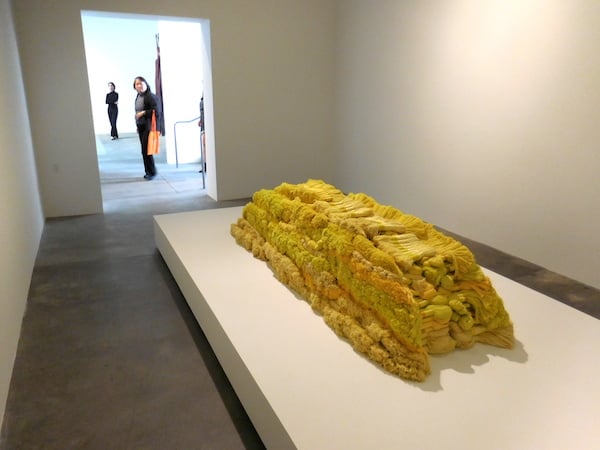
Sheila Hicks’s Banisteriopsis (1956-66) and Banisteriopsis II (1965-66/2010) in “A Revolution In the Making.”
Image: Ben Davis.
Occupying the vast raw space of an old flour factory in downtown LA, the new gallery weighs in at 100,000 square feet—bigger than the New Museum in New York, as the LA Times pointed out, and much more luxurious. Some 30,000 square feet are given to roomy, luminous galleries, and there will also be a full bookstore run by ArtBook and a swanky restaurant, Manuela.
It feels like a nice museum, which shouldn’t be surprising, considering that Paul Schimmel was himself a renowned museum curator before he joined Hauser & Wirth’s gallery empire as partner for the LA space. At the press conference yesterday, he described it as “the first art center in the Arts District,” adding that he hoped, via the endeavor, to “expand the notion of what a gallery can be.”
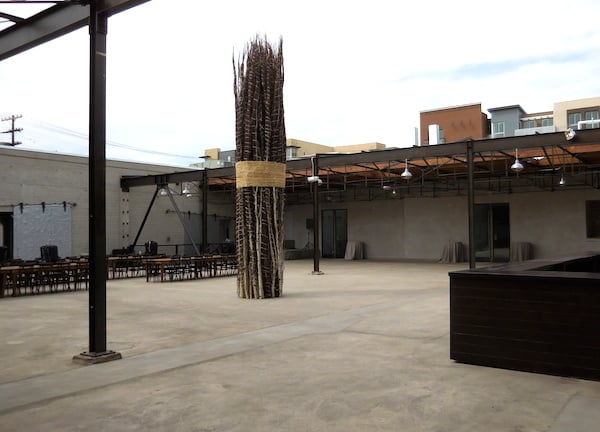
Jackie Winsor’s 30 to 1 Bound Trees in the courtyard of Hauser, Wirth & Schimmel.
Image: Ben Davis.
The building is spanned by a breezeway that is supposed to function as a passage through the block, accessing a big courtyard where passersby can take lunches in the sun. During the exhibition walkthrough, Schimmel’s partner in curating the inaugural exhibition, Jenni Sorkin, explained that the new gallery hoped to “alter people’s perception of LA and make them walk again.”
Now that’s ambitious.
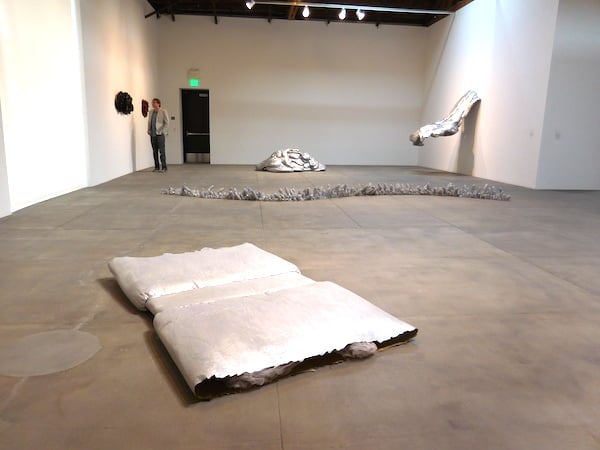
Installation view of “Revolution in the Making,” with Heidi Bucher’s Untitled (Bodyshells) (1974) in the foreground.
Image: Ben Davis.
In form and content, Hauser, Wirth & Schimmel is a massive monument to the “museum-quality gallery show.” Prices have become so bloated for major works of art in our recent era of silly money that an entire apparatus of scholarship and expensive non-commercial loans can be justified, approximating museum fare, if it just serves to sell a few works of art, or even just to build bridges to the right artists or collectors.
It’s similar to how Red Bull styles itself as a hip events company that just so happens to sell energy drinks. You know it is in the end really about selling Red Bull—but you also marvel at the spectacle it has built around this simple aim, and everything that is sustained by it. Only in the art world’s wonky calculus, that spectacle consists of aggressively intelligent curating instead of made-up extreme sports.
The opening attempt to make a big impression is “Revolution in the Making: Abstract Sculpture by Women, 1947-2016,” curated by Schimmel and Sorkin. It contains almost 100 works by 34 female artists, all in an abstract or semi-abstract artistic idiom.

Louise Nevelson, Sky Cathedral/Southern Mountain (1959).
Image: Ben Davis.
It’s an impressive lot. From way back, there’s a great 1959 Louise Nevelson (1899-1988) black-painted wood relief, on loan from the Museum of Contemporary Art, Los Angeles, and a suite of imposing Lee Bontecou (b. 1931) wall reliefs, looking like fossilized space vortexes.
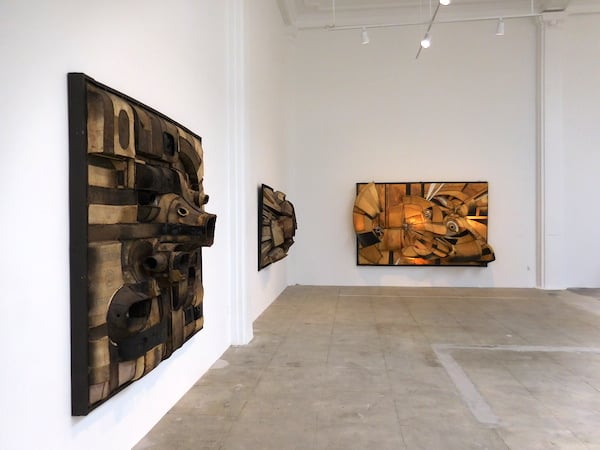
Installation view of Lee Bontecou.
Image: Ben Davis.
On the newer side, there’s a new work commissioned for the breezeway by Shinique Smith (b. 1971), consisting of fat cords of colorful knotted clothing, hung overhead like strings of giant, soft Mardi Gras beads, and the odd, bawdy sculptures of Dutch artist Lara Schnitger (b. 1969), who has a deft hand with low materials.

Lara Schnitger, V-plunge (2016).
Image: Ben Davis.
As an idea, this show feels nicely calibrated for this debut. It tells a story that feels socially relevant, filling a gap in art history.
At the same time, though, it’s not taking too big a risk. The greater part of the show consists of a sisterhood of superstars: Bontecou, Eva Hesse, Lynda Benglis, Yayoi Kusama, Isa Genzken, and Jessica Stockholder, to name just a handful of the figures surveyed here, are all names you can take to the bank.
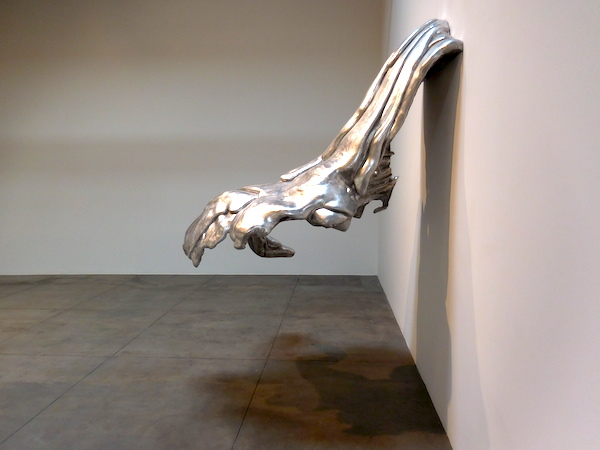
Lynda Benglis, Wing (1970).
Image: Ben Davis.
You may be so stunned by how good it all is that you almost forget to ask yourself what they all really have in common. My favorite part of the show is an addendum to the main event, a room full of documents dedicated to the early career of Louise Bourgeois, the legendary sculptor who is positioned as a kind of mater familias here. This scholarly annex gives you a window into what made this particular artist tick, showing her forceful personality as well as the milieu of feminist ferment around her.

Poster featured in a mini-show dedicated to Louise Bourgeois documents at Hauser, Wirth & Schimmel
Image: Ben Davis
A notebook page popped out at me, headed “Influence and Correlation” and written in Bourgeois’s elegant cursive. Seemingly addressing herself, the artist writes: “Your formal inventions are not the meaning of the work whereas other artists have exploited those formal ideas as the meaning and very essence of their works.”
Bourgeois’s mystique was very much tied to her sculpture’s psychosexual references and autobiographical insinuations, a fact that made it odd and out-of-step with the pure abstraction of her day. A cluster of Bourgeois’s deliberately gawky, sneakily anthropomorphic sculptures sit in the show’s first gallery. They have names like Depression Woman (1949-50) and Listening One (1947).
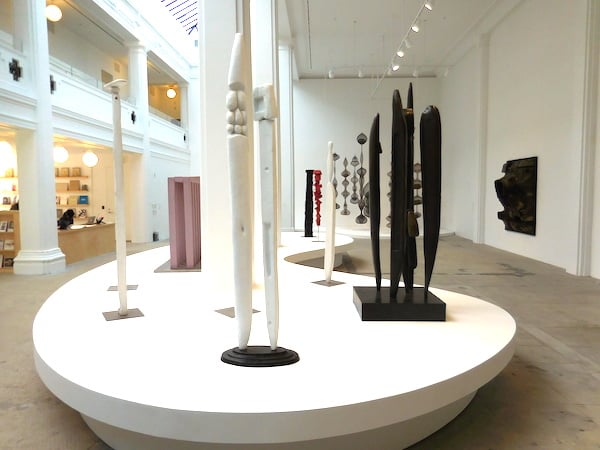
Installation view of Louise Bourgeois sculptures in “Revolution in the Making.”
Image: Ben Davis.
At the back of the same gallery are Ruth Asawa’s voluptuous, diaphanous, multilayered woven-wire hanging sculptures, which, as a contrast, have titles like Hanging Six-Lobed, Multi-Layered, with Double Sphere Suspended in the First and Last Lobes, and Single Spheres Suspended in the Second and Fourth Lobes (1967). Asawa took abstract form as the “meaning and essence of the work” in a way that Bourgeois definitely did not.
Indeed, even as Bourgeois pioneered abstraction as a vehicle to express her own lacerating personal narrative, Asawa saw abstraction as a refuge from the weight of personal history. Sent to a camp as a girl during the period of Japanese internment in the US, she once said, as Elizabeth A.T. Smith’s essay on her in the show catalogue recounts, “I no longer see myself as a Japanese or an American but as a citizen of the universe… I no longer want to nurse such wounds; I now want to wrap my fingers cut by aluminum shavings, and hands scratched by wire. Only these two things produce tolerable pains.”
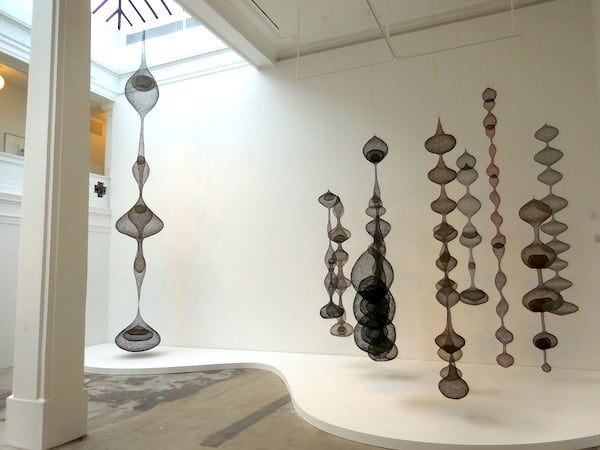
Installation view of Rush Asawa.
Image: Ben Davis.
A show so rich in treasures is a joy to see, from the wire-lattice constellations of the pioneering Venezuelan artist Gego (1912-1994), to a spidery new creation of nylon and magnets by the venerable, under-recognized Senga Nengudi (b. 1943). Teasing out the underlying vagueness of the connections within the whole is worthwhile, though, because it bears on how this gallery-that-wants-to-be-a-museum is functioning, beneath the rhetoric.
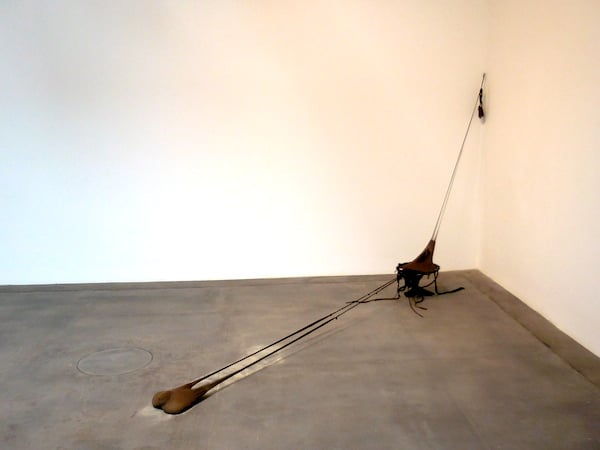
Senga Nengudi, R.S.V.P. Reverie—0 (2015)
Image: Ben Davis
The most important thing, Anne M. Wagner writes in the catalogue is “the ongoing need to explore how and to what ends women make sculpture. To do so, it is essential to put aside any lingering assumption that one answer fits all.” Later Wagner asks, seemingly putting a question mark over the whole premise of the show, “What are the parallels among women’s works? What went unshared? These are not necessarily easy questions to answer about any set of sculptures; the difficulties are not resolved if we learn that all the works were made by women.”
Elsewhere in the catalogue, Sorkin explains that her aim is to recover a tradition based on “the hand of the artist,” cutting against the notion that “live and lens-based” works were the privileged avenues of expression for female artists, a position she sees as having been a dogma of 1990s identity-based work. This argument is not without merit, but it’s painting with a pretty broad brush and an old battle to fight to boot: Genzken and Stockholder, in particular, have been patron saints of the fussy junk art that has dominated the 2000s.
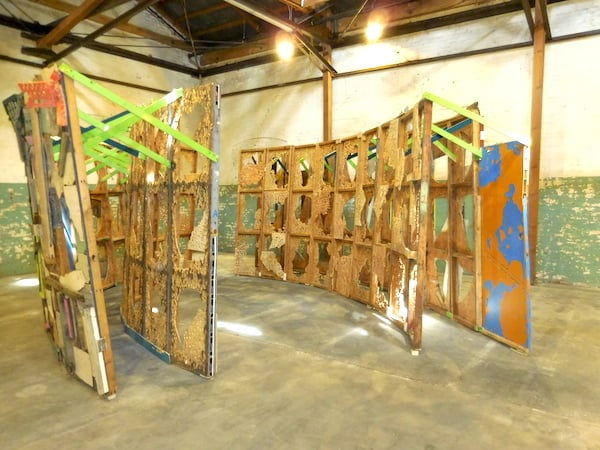
Abigail DeVille, Intersection (2014).
Image: Ben Davis.
The broad conceit is a way for the curators to bring an ecumenical selection of interesting artists together, albeit at the cost of making them all look kind of the same, highlighting the aspects of their art that look most like post-minimalism. A more focused premise than “Abstract Sculpture by Women” would have been less able to incorporate all the big names, and therefore less splashy—but also probably more coherent and educational. The focus on abstraction is itself a bit abstract.
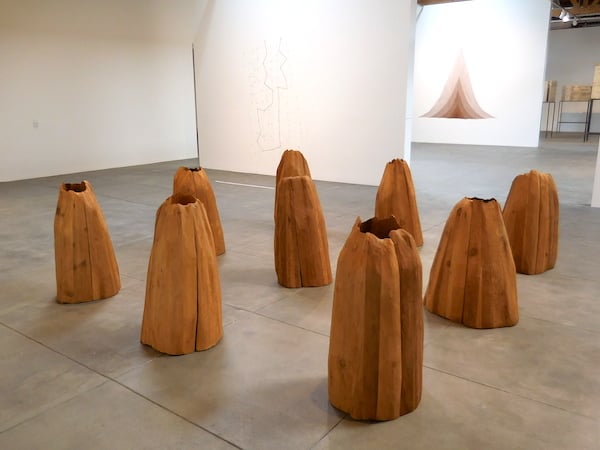
Installation view of “Revolution in the Making” with Ursula von Rydingsvard in foreground.
Image: Ben Davis.
In the early 1970s, the feminist art critic Lucy Lippard wrote that “[a] large-scale exhibition of women’s art in New York is necessary at this time for a variety of reasons… above all, because the New York museums have been particularly discriminatory, usually under the guise of being discriminating.”
But then, in Hauser, Wirth & Schimmel’s annex full of Bourgeois documents, there’s a display of a 1973 letter signed by Lippard and 18 others, including Joyce Kozloff, Linda Nochlin, Howardena Pindell, Nancy Spero, and Joan Snyder, to Museum of Modern Art head William Rubin. “We would like to express our strong support for a large scale museum exhibition of the sculpture of Louise Bourgeois,” it begins. “Her work has been seen primarily in group shows for many years now. We feel this lack and speak for others as well.”
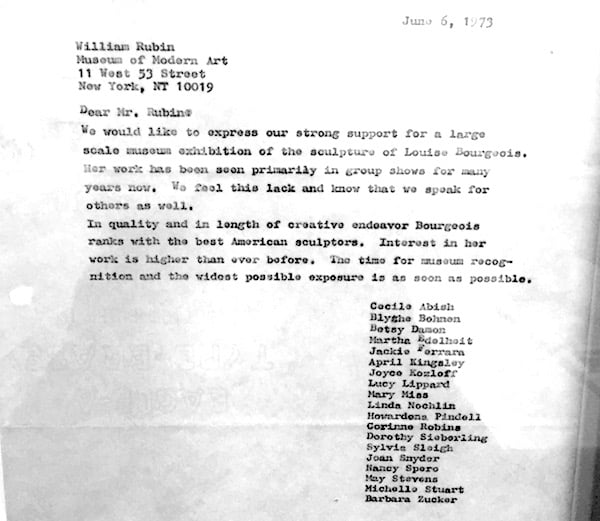
Letter featured in a mini-show dedicated to Louise Bourgeois documents at Hauser, Wirth & Schimmel
Image: Ben Davis
Where are we in relation to these two demands? Is a show like this a necessary act of advocacy, and a vehicle through which some worthy, still-neglected voices can join the conversation? Or is it a purgatory where strong individual voices have been consigned, because the market remains too cowardly to take a risk on them as “museum-quality” individuals?
It could be a little of both, which may also say something about the strengths and pitfalls of this whole endeavor, which, through its sheer ambition, is going to have implications that echo far and wide.
“Revolution in the Making: Abstract Sculpture by Women, 1947-2016” is on view at Hauser, Wirth & Schimmel, March 13-September 4, 2016.